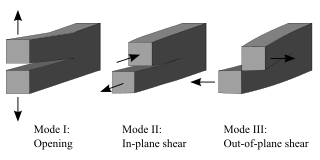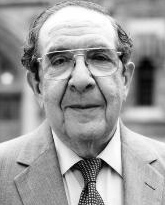Related Research Articles

Fracture is the appearance of a crack or complete separation of an object or material into two or more pieces under the action of stress. The fracture of a solid usually occurs due to the development of certain displacement discontinuity surfaces within the solid. If a displacement develops perpendicular to the surface, it is called a normal tensile crack or simply a crack; if a displacement develops tangentially, it is called a shear crack, slip band, or dislocation.

Fracture mechanics is the field of mechanics concerned with the study of the propagation of cracks in materials. It uses methods of analytical solid mechanics to calculate the driving force on a crack and those of experimental solid mechanics to characterize the material's resistance to fracture.
Alan Arnold Griffith, was an English engineer and the son of Victorian science fiction writer George Griffith. Among many other contributions, he is best known for his work on stress and fracture in metals that is now known as metal fatigue, as well as being one of the first to develop a strong theoretical basis for the jet engine. Griffith's advanced axial-flow turbojet engine designs were integral in the creation of Britain's first operational axial-flow turbojet engine, the Metropolitan-Vickers F.2, which first ran successfully in 1941. Griffith, however, had little direct involvement in actually producing the engine, after he moved in 1939 from leading the engine department at the Royal Aircraft Establishment to start work at Rolls-Royce.

Ronald Samuel Rivlin was a British-American physicist, mathematician, rheologist and a noted expert on rubber.
Rubber toughening is a process in which rubber nanoparticles are interspersed within a polymer matrix to increase the mechanical robustness, or toughness, of the material. By "toughening" a polymer it is meant that the ability of the polymeric substance to absorb energy and plastically deform without fracture is increased. Considering the significant advantages in mechanical properties that rubber toughening offers, most major thermoplastics are available in rubber-toughened versions; for many engineering applications, material toughness is a deciding factor in final material selection.
Professor Leslie Ronald George Treloar, OBE was a leading figure in the science of rubber and elasticity, and writer of a number of influential texts.
Graham Johnson Lake was an English scientist known for his contributions to understanding rubber's fatigue limit, and a former professional English cricketer.
Polymer fracture is the study of the fracture surface of an already failed material to determine the method of crack formation and extension in polymers both fiber reinforced and otherwise. Failure in polymer components can occur at relatively low stress levels, far below the tensile strength because of four major reasons: long term stress or creep rupture, cyclic stresses or fatigue, the presence of structural flaws and stress-cracking agents. Formations of submicroscopic cracks in polymers under load have been studied by x ray scattering techniques and the main regularities of crack formation under different loading conditions have been analyzed. The low strength of polymers compared to theoretically predicted values are mainly due to the many microscopic imperfections found in the material. These defects namely dislocations, crystalline boundaries, amorphous interlayers and block structure can all lead to the non-uniform distribution of mechanical stress.
Alan Neville Gent was a professor at the University of Akron. He was recognized during his lifetime as a world-leading authority on the topics of adhesion physics, crystalline and glassy polymers, and the fracturing of rubber.

The Charles Goodyear Medal is the highest honor conferred by the American Chemical Society, Rubber Division. Established in 1941, the award is named after Charles Goodyear, the discoverer of vulcanization, and consists of a gold medal, a framed certificate and prize money. The medal honors individuals for "outstanding invention, innovation, or development which has resulted in a significant change or contribution to the nature of the rubber industry". Awardees give a lecture at an ACS Rubber Division meeting, and publish a review of their work in the society's scientific journal Rubber Chemistry and Technology.
The Melvin Mooney Distinguished Technology Award is a professional award conferred by the ACS Rubber Division. Established in 1983, the award is named after Melvin Mooney, developer of the Mooney viscometer and of the Mooney-Rivlin hyperelastic law. The award consists of an engraved plaque and prize money. The medal honors individuals "who have exhibited exceptional technical competency by making significant and repeated contributions to rubber science and technology".
George Stafford Whitby (1887–1972) was the head of the University of Akron rubber laboratory and for many years was the only person in the United States who taught rubber chemistry. Whitby received the Charles Goodyear Medal in 1954 and in 1972, he was inducted into the International Rubber Science Hall of Fame. In 1986 the Rubber Division established the George Stafford Whitby Award in his honor.
Ray Putnam Dinsmore was a rubber scientist, known for pioneering the use of rayon as a reinforcing material in auto tires. In 1928, Dinsmore patented the first water-emulsion synthetic rubber in the United States. The material later became a staple of the rubber industry during the World War II shortage of natural rubber. Dinsmore worked for the Goodyear Tire and Rubber Company and developed Chemigum, an early synthetic rubber. Dinsmore hired noted rubber physicist Samuel D. Gehman, and he collaborated with Lorin Sebrell. His authored a popular review on the topic of rubber chemistry for the American Chemical Society's 75th Anniversary. Dinsmore served as chairman of the Rubber Division of the American Chemical Society in 1927. He received the 1947 Colwyn medal and was named the 1955 Charles Goodyear Medalist.
The A. A. Griffith Medal and Prize was awarded annually from 1965 to 2021 by the Institute of Materials, Minerals and Mining in commemoration of Alan Arnold Griffith.
Dr. Karl Alfred Grosch (1923-2012) was a rubber industry scientist noted for his contributions to understanding tire friction and abrasion. Dr. Grosch is the developer of the LAT 100 Abrasion tester that is used widely in the tire industry to evaluate the friction and wear properties of rubber compounds.

Maurice Morton was a polymer author, educator, and researcher. He was the first director of the University of Akron's Institute of Rubber Research, which in 1993 was renamed the Maurice Morton Institute of Polymer Science.
Aubert Y. Coran (1932-2020) was an American scientist noted for his contributions to thermoplastic elastomers and vulcanization chemistry of rubber. In 1983, he won the Melvin Mooney Distinguished Technology Award, bestowed by the American Chemical Society to individuals "who have exhibited exceptional technical competency by making significant and repeated contributions to rubber science and technology". In 1995, the rubber division of the American Chemical Society bestowed on Coran the Charles Goodyear Medal in honor of his international contributions to polymer science and development.
Alan Hugh Muhr is a retired TARRC scientist noted for contributions to understanding the mechanics elastomer applications, including laminated rubber isolators, marine fenders, automotive mounts, and structural energy dissipation systems
James Busfield is a Queen Mary University of London professor, and head of the United Kingdom's largest research group in the area of Soft Matter.
Liqun Zhang is the president of South China University of Technology.
References
- ↑ "Colwyn Medal award winners". iom3. Archived from the original on 26 September 2017. Retrieved 25 September 2017.
- ↑ Rivlin, R. S., & Thomas, A. G. (1953). Rupture of rubber. I. Characteristic energy for tearing. Journal of Polymer Science, 10(3), 291-318.
- ↑ Thomas, A. G. (1955). "Rupture of rubber. II. The strain concentration at an incision". Journal of Polymer Science. 18 (88): 177–188. Bibcode:1955JPoSc..18..177T. doi:10.1002/pol.1955.120188802.
- ↑ Greensmith, H. W.; Thomas, A. G. (1955). "Rupture of rubber. III. Determination of tear properties". Journal of Polymer Science. 18 (88): 189–200. Bibcode:1955JPoSc..18..189G. doi:10.1002/pol.1955.120188803.
- ↑ "The phenomenon of rupture and flow in solids", Philosophical Transactions of the Royal Society, Vol. A221 pp.163-98
- ↑ "IOM3 Awards website"
- ↑ "CHARLES GOODYEAR MEDALISTS, 1941-2014". Rubber and Plastics News. 28 April 2014. Retrieved 8 September 2017.
- ↑ "Prof Alan Thomas (1927 – 2019)".